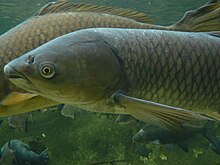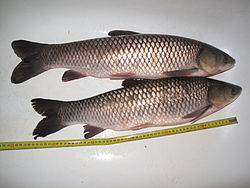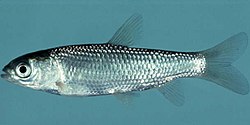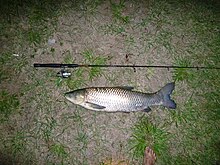
Cyprinidae is a family of freshwater fish commonly called the carp or minnow family, including the carps, the true minnows, and their relatives the barbs and barbels, among others. Cyprinidae is the largest and most diverse fish family, and the largest vertebrate animal family overall, with about 3,000 species; only 1,270 of these remain extant, divided into about 200 valid genera. Cyprinids range from about 12 mm (0.5 in) in size to the 3 m (9.8 ft) giant barb. By genus and species count, the family makes up more than two-thirds of the ostariophysian order Cypriniformes. The family name is derived from the Greek word kyprînos.

The term carp is a generic common name for numerous species of freshwater fish from the family Cyprinidae, a very large clade of ray-finned fish mostly native to Eurasia. While carp are prized quarries and are valued as both food and ornamental fish in many parts of the Old World, they are considered trash fish and invasive pests in many parts of Africa, Australia and most of the United States.

The Eurasian carp or European carp, widely known as the common carp, is a widespread freshwater fish of eutrophic waters in lakes and large rivers in Europe and Asia. The native wild populations are considered vulnerable to extinction by the International Union for Conservation of Nature (IUCN), but the species has also been domesticated and introduced into environments worldwide, and is often considered a destructive invasive species, being included in the list of the world's 100 worst invasive species. It gives its name to the carp family, Cyprinidae.
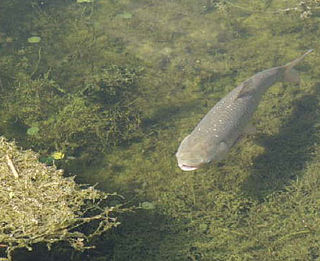
Several species of heavy-bodied cyprinid fishes are collectively known in the United States as Asian carp. Cyprinids from the Indian subcontinent—for example, catla and mrigal —are not included in this classification and are known collectively as "Indian carp". Asian carp are considered invasive species in the United States. In June, 2022, the EPA funded initiative to rebrand Asian Carp as Copi was announced. The new name — Copi — is a part of the Federal and multi-state campaign to reintroduce the carps to the public as a healthy and responsible seafood option in order to decrease its numbers in U.S. waterways.

The black carp or Chinese black roach is a species of cyprinid freshwater fish and the sole extant species of the genus Mylopharyngodon. It is native to lakes and rivers in East Asia, ranging from the Amur Basin across China to Vietnam. One of the largest cyprinids in the world, the black carp has a typical length of 60–120 cm (23.5–47 in), though it can reach up to 1.9 m in length and 109 kg (240 lb) in weight. It is carnivorous and generally feeds on invertebrates such as snails, clams and mussels.

The bighead carp is a species of cyprinid freshwater fish native to East Asia, and is one of several Asian carps introduced into North America. It is one of the most intensively exploited fishes in fish farming, with an annual worldwide production of over three million tonnes in 2013, principally from China. Unlike the omnivorous common carp, bighead carp are primarily filter-feeding algae eaters, preferentially consuming zooplankton but also phytoplankton and detritus.

The silver carp is a species of freshwater cyprinid fish, a variety of Asian carp native to China and eastern Siberia, from the Amur River drainage in the north to the Xi Jiang River drainage in the south. Although a threatened species in its natural habitat, it has long been cultivated in China as one of the "Four Famous Domestic Fish" (四大家鱼) together with Bighead carp, Black carp and Grass carp. By weight, more silver carp are produced worldwide in aquaculture than any other species of fish except for the grass carp. Silver carp are usually farmed in polyculture with other Asian carp, or sometimes with catla or other fish species.

Myriophyllum spicatum is a submerged aquatic plant which grows in still or slow-moving water. It is native to Europe, Asia, and North Africa, but has a wide geographic and climatic distribution among some 57 countries, extending from northern Canada to South Africa. It is considered to be a highly invasive species.

The fishing industry in the land-locked country of Laos is a major source of sustenance and food security to its people dwelling near rivers, reservoirs and ponds. Apart from wild capture fisheries, which is a major component of fish production, aquaculture and stocking are significant developments in the country. Historically, fishing activity was recorded in writings on the gate and walls of the Wat Xieng Thong in Luang Prabang dated 1560. For many Laotians, freshwater fish are the principal source of protein. The percentage of people involved in regular fishing activity is very small, only near major rivers or reservoirs, as for most of the fishers it is a part-time activity.

Carp is a common name for various species of freshwater fish from the family Cyprinidae that are native to Eurasia and sought after by some recreational fishermen. Certain carp species have been introduced, with mixed results, to various other locations around the world, and even declared invasive in certain regions.

China, with one-fifth of the world's population, accounts for two-thirds of the world's reported aquaculture production.
Boskop Dam is an earth-fill type dam on the Mooi River, near Potchefstroom, North West Province, South Africa. It was constructed in 1959. The main purpose of the dam is for irrigation and domestic usage. Its hazard potential is ranked as high, due to poor maintenance and the development of sink holes.

Ponchatoula Creek is a 26.1-mile-long (42.0 km) tributary of the Natalbany River in Tangipahoa Parish, Louisiana. The two waterways join where a section of the Natalbany forms the boundary between Tangipahoa Parish and Livingston Parish. Ponchatoula Creek originates west of Old US Highway 51, 1 mile (1.6 km) north of Independence. The creek is entirely within Tangipahoa Parish.

The popeye shiner is a North American species of freshwater cyprinid fish.

Cirrhinus molitorella is a species of ray-finned fish in the genus Cirrhinus found mainly in southern China and Vietnam.

Canadian aquatic invasive species are all forms of life that traditionally has not been native to Canada's waterways. In Eastern Canada, non-native plant and animal species are a concern to biologists. Bringing non-native species such as invasive fishes into Canada can damage the environment and ecosystem by repressing native species due to food competition or preying. Invasive fishes enter the fresh waters of Canada in several ways including drifting, deliberate introduction, accidental release, experimental purposes and, most commonly, through the attachment on international boat hulls. Invasive species are the second biggest threat to fish and other marine life in Canada behind loss of habitat and degradation. The threat to native species is primarily caused by impacts on the food web; however, invasive species also bring dangerous pathogens and physically interfere with existing aquatic life. Invasive species include sea lampreys, zebra mussels, smallmouth bass, European green crab, vase tunicate, and sea squirts.

Asian carp, an invasive species of fish introduced into North America, pose a major threat to the ecology, environment, economy, and way of life in the Upper Midwest and Great Lakes region of the United States and Canada. The term refers to a group of cyprinid fish species originally native to East Asia, of which include several are known to be invasive in the United States, and represent the most urgent potential danger to the ecology of the Great Lakes.

Squaliobarbinae is a small subfamily of the carp and minnow family, Cyprinidae, which consists of three monotypic genera which have their natural distributions in eastern Asia. Two species, the grass carp and the black carp, have been introduced to other parts of the world for weed control and aquaculture. They are large cyprinids characterised by an enlarged subtemporal fossa, the palate articulating with the supraethmoid, an enlarged intercalar bone in the cranial vault, and a divided levator posterior muscle.
